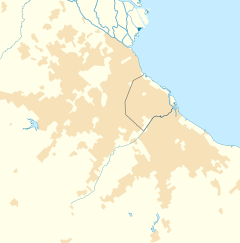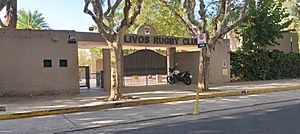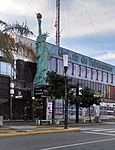Munro, Buenos Aires facts for kids
Quick facts for kids
Munro
|
|
|---|---|
|
District
|
|

Munro commercial center on Avenida Mitre
|
|
| Country | |
| Province | |
| Partido | |
| Founded | 30 April 1912 |
| Elevation | 26 m (85 ft) |
| Population
(2001 census [INDEC])
|
|
| • Total | 35,844 |
| CPA Base |
B 1605
|
| Area code(s) | +54 11 |
Munro is a city in Argentina, located north of Buenos Aires. It's famous for its many stores selling jeans and clothes. The city is about 20 kilometers from downtown Buenos Aires.
Munro is surrounded by other towns. To the north are Villa Adelina, Carapachay, and Martínez. Villa Ballester is to the west, Florida Este to the south, and Olivos to the east.
Many sports clubs are in Munro. Some of these include Unión Vecinal de Fomento Munro (started in 1922), Olivos Rugby Club (1927), and Club Unión de Munro (1946).
Munro also has several local industries. These include factories that make clothing, lumber, steel, and food. The famous Lumiton filming studios were once located here. Today, they are a museum where you can learn about old movies.
Contents
History of Munro
Munro began to grow when a train station was built on April 30, 1912. Before that, a grocery store had been there since 1850. The railway company bought land near the tracks and sold it.
The train station was named after Duncan Mackay Munro. He was a Scottish immigrant who managed several railway companies in Argentina. Duncan Munro also helped build roads and supported farming. He gave land to build the train station and a park in the area.
His daughter, Adelina Munro Drysdale, also has a town named after her: Villa Adelina. Another nearby town, "Drysdale," was later renamed Carapachay.
On June 11, 1922, 49 neighbors created the Unión Vecinal de Fomento de Munro. As more people moved in, many stores opened. This created an important shopping area.
Munro was also home to Lumiton Studios. This movie company was started by Enrique Telémaco Susini. From 1931 to 1952, Lumiton made over 180 full-length films. It became one of the most famous studios in Argentine cinema.
The first school in the area, School Nº4 Domingo Faustino Sarmiento, opened on November 11, 1961. The Santa María Reina church was founded on March 22, 1965.
Munro's Shopping Boom
Avenida Mitre became the main shopping street in Munro. This happened after American jeans companies like Lee and Wrangler opened stores there in the early 1970s. Levi's followed in 1976. They sold clothes that were cheaper than in other stores.
In 1981, Avenida Mitre was improved, making the shopping area more modern. In 1984, the Governor of Buenos Aires, Alejandro Armendáriz, declared Munro the "Capital de la Indumentaria." This means "Clothing Capital," and it helped promote clothing sales in the area.
During the 1970s and 1980s, the shopping center was very successful. It was a major part of the local economy. Many people came to Munro to buy jeans, t-shirts, and sweaters. These items were often 50% cheaper than in other places.
In 1995, the Centro Cultural Munro (Munro Cultural Center) opened. It has a large hall that can hold 870 people for events.
Population
Munro covers an area of about 5.8 square kilometers. In 2001, its population was 35,844 people. This makes it the third most populated city in its district. In 1991, there were 36,188 citizens, so the population slightly decreased by 2001.
Education
Munro has several schools and educational places. Some well-known ones include:
- Institute of Integral Education Munro
- Clases Particulares De Inglés Y Matemática (Private English and Math Classes)
- Escuela Primaria No. 32 "MARIA LUISA IRIBARNE DE ORTIZ" (Primary School No. 32)
- Higher Institute of Teacher Training and Technical No. 77
A German school, Deutsche Schule Munro, was also once located in the area.
Notable People
Some famous people have come from Munro:
- Julio Bocca
- Jorge Sotomayor (born 1988), an Argentine footballer
- Miguel Abuelo
Sports
The most popular sport in Munro is football. Many social clubs in the city offer football and other activities.
Club Atlético Colegiales was founded in 1908 in Buenos Aires. The club is part of the Argentine Football Association. In 1948, Colegiales moved to its current location in Munro (now Florida Oeste).
Rugby union and field hockey are also popular. These sports are played at the Olivos Rugby Club, which started in 1927. The rugby teams compete in tournaments organized by the Unión de Rugby de Buenos Aires (URBA).
Gallery
See also
 In Spanish: Munro (Buenos Aires) para niños
In Spanish: Munro (Buenos Aires) para niños












